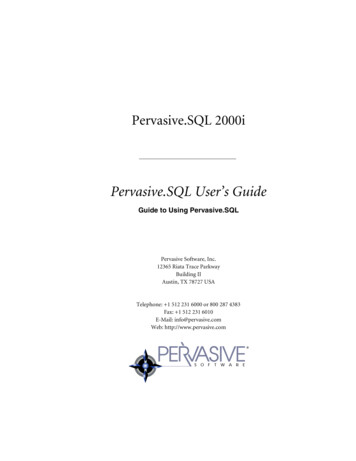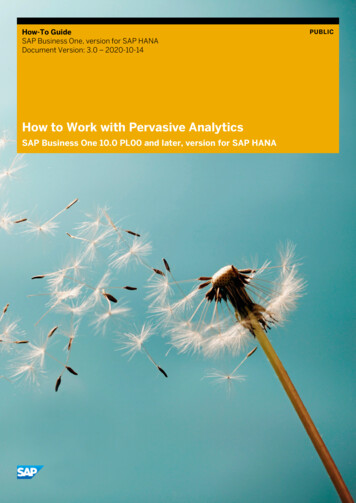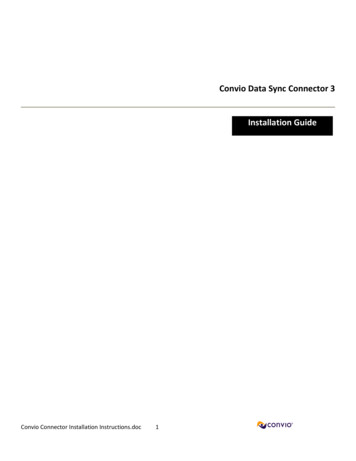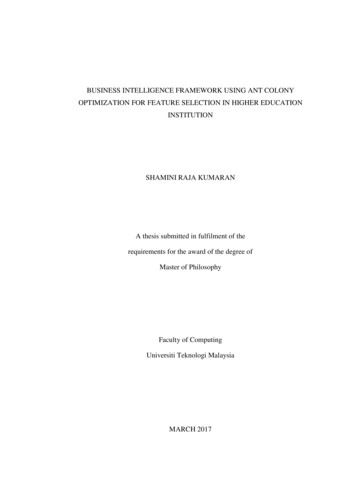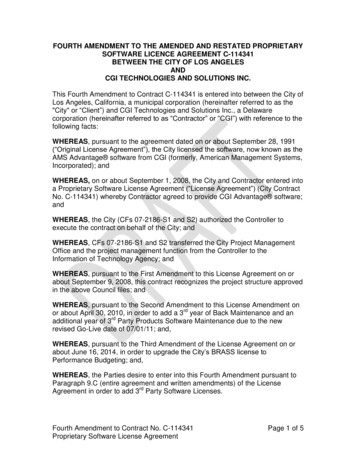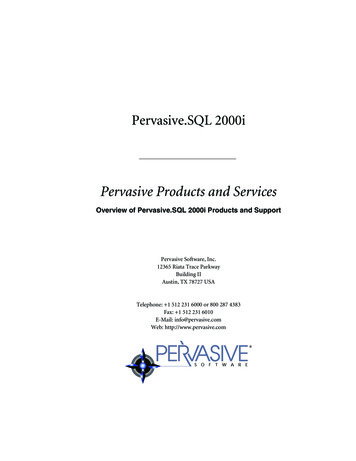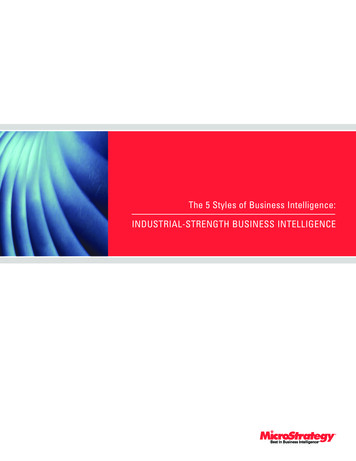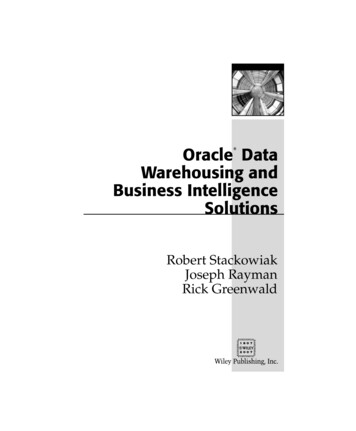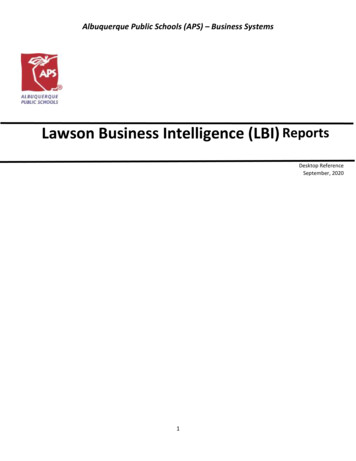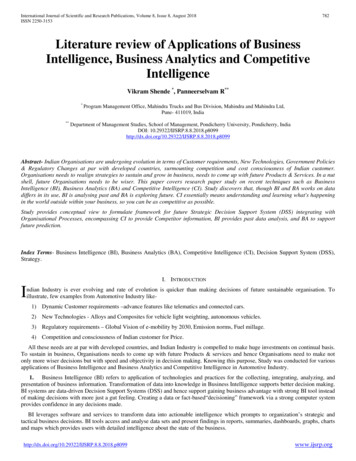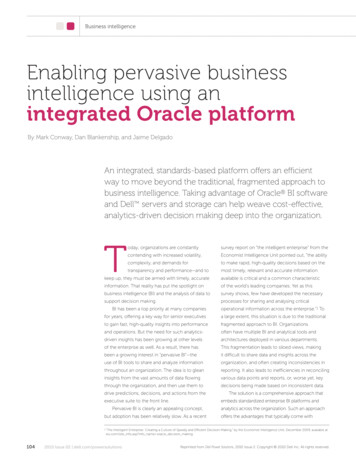
Transcription
Business intelligenceEnabling pervasive businessintelligence using anintegrated Oracle platformBy Mark Conway, Dan Blankenship, and Jaime DelgadoAn integrated, standards-based platform offers an efficientway to move beyond the traditional, fragmented approach tobusiness intelligence. Taking advantage of Oracle BI softwareand Dell servers and storage can help weave cost-effective,analytics-driven decision making deep into the organization.Today, organizations are constantlysurvey report on “the intelligent enterprise” from thecontending with increased volatility,Economist Intelligence Unit pointed out, “the abilitycomplexity, and demands forto make rapid, high-quality decisions based on thetransparency and performance—and tomost timely, relevant and accurate informationkeep up, they must be armed with timely, accurateavailable is critical and a common characteristicinformation. That reality has put the spotlight onof the world’s leading companies. Yet as thisbusiness intelligence (BI) and the analysis of data tosurvey shows, few have developed the necessarysupport decision making.processes for sharing and analysing criticalBI has been a top priority at many companiesoperational information across the enterprise.”1 Tofor years, offering a key way for senior executivesa large extent, this situation is due to the traditionalto gain fast, high-quality insights into performancefragmented approach to BI. Organizationsand operations. But the need for such analytics-often have multiple BI and analytical tools anddriven insights has been growing at other levelsarchitectures deployed in various departments.of the enterprise as well. As a result, there hasThis fragmentation leads to siloed views, makingbeen a growing interest in “pervasive BI”—theit difficult to share data and insights across theuse of BI tools to share and analyze informationorganization, and often creating inconsistencies inthroughout an organization. The idea is to gleanreporting. It also leads to inefficiencies in reconcilinginsights from the vast amounts of data flowingvarious data points and reports, or, worse yet, keythrough the organization, and then use them todecisions being made based on inconsistent data.drive predictions, decisions, and actions from theexecutive suite to the front line.The solution is a comprehensive approach thatembeds standardized enterprise BI platforms andPervasive BI is clearly an appealing concept,but adoption has been relatively slow. As a recentanalytics across the organization. Such an approachoffers the advantages that typically come with1 “TheIntelligent Enterprise: Creating a Culture of Speedy and Efficient Decision-Making,” by the Economist Intelligence Unit, December 2009, available ateiu.com/site info.asp?info name oracle decision making.1042010 Issue 02 dell.com/powersolutionsReprinted from Dell Power Solutions, 2010 Issue 2. Copyright 2010 Dell Inc. All rights reserved.
InteractivedashboardsReportingand publishingAd hoc queriesand analysesDetectionand alertingMobile andoffline accessMicrosoft OfficeintegrationSearchEmbeddeddataPervasive information accessStrategicplanningPlanning ERPanalyticsCRManalyticsIndustryanalyticsCommon analytic foundationOnline transactionprocessing (OLTP)and operationaldata store (ODS)systemsData warehouseand data martsFigure 1. IntegratedOracle platform forpervasive businessintelligenceOracle EssbaseOracle BI ServerOLAP systemsOracle, PeopleSoft,JD Edwards, Siebel,SAP, and customsystemsMicrosoft OfficeExcel and XMLBusinessprocessesstandardization, including increased efficiencyacquisition of Hyperion and its financial-that includes three fundamental componentsand consistency as well as reduced complexity.analytics and performance-management tools,(see Figure 1):That perspective is at the heart of Oracle’sand the acquisition of Siebel and its extensive Oracle BI Server: Oracle BI Server isapproach to BI. The Oracle enterprise BIsuite of analytical technologies. Oracle hasplatform encompasses a comprehensivefocused on the integration and standardizationa scalable, sophisticated data access,range of BI tools and technologies. But,of BI tools using open technologies to createaggregation, and calculation enginemore important, it integrates these toolsa true enterprise BI platform that supports allfor creating real-time intelligence fromand technologies to create a platform that isthree of the fundamental types of BI—givingheterogeneous data sources—includingmore than the sum of its parts. Organizationsorganizations the query and reporting toolsOracle, Microsoft SQL Server , IBM can take advantage of this BI platform asneeded to understand their business, theDB2, and Teradata software—andwell as Dell servers and storage to create aanalytic tools needed to pose a range ofdelivering it efficiently across even large-scalable, enterprise-class approach to BI andquestions, and the modeling tools neededscale enterprise environments. It canultimately drive fact-based decision makingto look ahead, manage risk and uncertainty,semantically integrate information and,and increased business agility.and exploit opportunities. With this platform,through a combination of a distributedOracle was recently recognized by IDC as thequery engine and a logical, semanticOracle business intelligenceplatform componentslargest vendor in business analytics in 2008.2 Inrepresentation of the data, can enableJanuary, Oracle was positioned as a “leader” inorganizations to represent multipleTo help meet the BI needs of organizationsGartner’s BI Platform Magic Quadrant.3physical data sources as a single,of all sizes, Oracle has made significantinvestments in this area—including the2 “WorldwideThe Oracle platform is designed tosupport pervasive BI with a unified foundationsimplified data structure to end-user tools.This simplified view can then be accessedBusiness Analytics Software 2009–2013 Forecast and 2008 Vendor Shares,” by IDC, Doc #219383, August 2009.3 “MagicQuadrant for Business Intelligence Platforms,” by Rita L. Sallam, Bill Hostmann, James Richardson, and Andreas Bitterer, Gartner, Inc., January 29, 2010. The Magic Quadrant is copyrighted 2010 byGartner, Inc. and is reused with permission. The Magic Quadrant is a graphical representation of a marketplace at and for a specific time period. It depicts Gartner’s analysis of how certain vendors measureagainst criteria for that marketplace, as defined by Gartner. Gartner does not endorse any vendor, product, or service depicted in the Magic Quadrant, and does not advise technology users to select onlythose vendors placed in the “Leaders” quadrant. The Magic Quadrant is intended solely as a research tool, and is not meant to be a specific guide to action. Gartner disclaims all warranties, express or implied,with respect to this research, including any warranties of merchantability or fitness for a particular purpose.Reprinted from Dell Power Solutions, 2010 Issue 2. Copyright 2010 Dell Inc. All rights reserved.dell.com/powersolutions 2010 Issue 02105
Business intelligencemetadata model that consists of three tiers: a“ For IT departments, anenterprise BI platformhelps to streamline BImodeling, reduce the needfor support, and simplifychanges and upgrades.”physical layer that allows organizations to importthe table structures of their existing data sources,a semantic object layer that lets them create asimplified semantic representation of multiple datasources and a model of the business that reflectsthe end user’s perspective, and a presentation layerthat exposes this business model to end users.This common enterprise information modelis accessed by Oracle analytics applications andend-user BI tools, giving each user and departmentthe same consistent view of information,customized to their needs. Unlike the traditionalapproach, which typically requires organizationsby the end-user tools through a standard SQL-to use different metadata for their ad hoc tools,based interface.reporting tools, and dashboard tools, the Oracle Oracle Essbase: This online analytical processingapproach avoids the need to maintain multiple(OLAP) server software provides an environmentmetadata environments for different types of users.for the rapid development of custom analyticOrganizations can instead “model once, deployand enterprise performance-managementeverywhere”—that is, they can define key metricsapplications. Based on a high-performanceand calculations in one place, and then use thatcalculation engine, it provides rapid responsebase to deliver a consistent view of informationtimes and an intuitive interface, enabling users toacross the organization to support efficient,interact with the data quickly without requiringeffective decision making.support from technical experts—helping them toDeployingpervasive BIImplementing true pervasiveBI can present significantdifficulties for organizationscontending with complexbusiness processes, data silos,and other challenges. In thispodcast, BI experts from Delland Oracle share insightson trends and best practicesthat organizations can begintaking advantage of today.oracle.com/goto/bipodcastanalyze the metrics that influence performanceComprehensive toolsand enhance their decision making. (For moreRunning the Oracle BI foundation on Dellinformation, see the “Thinking ahead with Oracleservers and storage provides a unified enterpriseEssbase” sidebar in this article.)infrastructure for a comprehensive suite of BI and Oracle Real Time Decisions (RTD): Oracleanalytics tools. These tools provide organizationsRTD is a high-performance transactional serverwith a variety of key capabilities, includingplatform and a predictive analytics engine thatthe following:lets organizations “embed” analytics and BIinto operational processes. Using a service- Production reporting: The Oracle BI Publisheroriented Java 2 Platform, Enterprise Editionintegrated reporting component enables(J2EE) architecture, it is designed to providethe creation of highly formatted templates,real-time decisions and recommendations toreports, and documents, such as checks andhelp organizations align frontline actions withgovernment forms, in complex and distributedperformance goals. Oracle RTD can supportenvironments. The Oracle architecturedecision logic based on user-defined rules orenables organizations to generate and deliverprovide automatically managed self-learninginformation to employees, customers, andpredictive models, enabling organizations topartners securely and in the appropriate format.learn from each interaction and adjust theirEnd users can work with familiar tools such asprocesses in real time.Microsoft Office Word or Adobe Acrobat forreport layouts.A key element in the Oracle BI approach is itscommon enterprise information model, a unified1062010 Issue 02 dell.com/powersolutions Interactive dashboards: A thin client solutionprovides interactive collections of analyticReprinted from Dell Power Solutions, 2010 Issue 2. Copyright 2010 Dell Inc. All rights reserved.
Thinking ahead with Oracle EssbaseDecision makers are constantly trying to determine what is likelyto happen in the future—and pervasive business intelligence (BI)can help users across the organization do just that.Oracle Essbase puts powerful analytical tools directly intothe hands of end users. Among other features, it enables theseusers to perform forward-looking analyses that model complexscenarios and create forecasts. They can use these tools toidentify patterns, such as determining which customers spendthe most, and to explore questions such as “What if demandfalls short of forecast?” or “What if we rolled out this productnationwide?” The ability to interact quickly and easily with thedata—as opposed to reading through static reports—helpsincrease user adoption of the system and supports rapid,focused decision making.At its core, Oracle Essbase contains a high-performancecalculation engine with more than 350 prebuilt functions.Oracle Essbase also provides a rapid application developmentenvironment that is managed by the business, enabling users toquickly create applications for querying and reporting, analytics,and forward-looking modeling. It also enables pervasive BI bysupporting extremely fast query response times for vast numbersof simultaneous users, large data sets, and complex models.Oracle Essbase also helps simplify enterprise BI support forIT departments. It can be configured, deployed, and maintainedby the business organization, and its n-tier architecture providesconnection pooling, load balancing, and automatic failoverto help meet service-level requirements. Because it workswith both 32- and 64-bit computing, it is capable of massivescalability for enterprise-wide deployments. Its support for64-bit architectures also enables larger analytical models withshorter calculation times than would be possible in 32-bitenvironments, helping increase the potential size of analyticapplications and the number of concurrent users.Meanwhile, user scalability features such as caching,multi-threading, partitioning, and cross-platform supportenable IT professionals to use a reduced number of serversto support many analytic applications and large usercommunities. Oracle Essbase also includes a number ofmanageability features, such as Microsoft .NET developmenttools, certified enterprise resource planning (ERP) andcustomer relationship management (CRM) applicationintegration adapters, administrative wizards, and automatedmaintenance scripts—all of which help reduce the deploymentand maintenance costs of pervasive BI.content with a rich variety of visualization tools.understandable concepts. End users do notRunning on a Web-based architecture, theseneed to understand physical data storagedashboards provide end users with informationto combine data from multiple enterprisefiltered and personalized for their specificinformation sources.identity, function, or role based on predefinedsecurity rules. The interactive interface helpsTo further drive pervasive BI, Oracle BImake the presentation of data intuitive, relevant,Applications provide prebuilt applications thatand easy to understand, while guided navigationdeliver intuitive, role-based intelligence throughoutand alerts help users gain insight and takethe organization—from frontline employees toaction. Making information personalized andsenior management. Broadly speaking, theseproviding it in the appropriate context is oneapplications fall into two categories: customerof the keys to encouraging user adoption andrelationship management (CRM) applicationsmoving organizations along the pervasive BIsuch as sales or customer analytics software, andmaturity curve.enterprise resource planning (ERP) applications Ad hoc queries and analyses: End users cansuch as financial, supply chain, or humancreate new analyses or modify existing analysesresources analytics software. They each includein dashboard pages. To help free users fromfour key components: a prebuilt warehouse; pre-data structure complexity, the metadata layermapped metadata embedding best practices forof Oracle BI offers a logical view of metrics,metrics and key performance indicators; prebuilthierarchies, and calculations expressed inextract, transform, and load (ETL) capabilities toReprinted from Dell Power Solutions, 2010 Issue 2. Copyright 2010 Dell Inc. All rights reserved.dell.com/powersolutions 2010 Issue 02107
Business intelligenceAccelerating business intelligence with Dell ServicesDell Services uses a holistic, collaborative approach to businessintelligence (BI) analytics that incorporates information frommultiple sources to give management comprehensive reportingon financial and operational performance. The Dell Servicesapproach is integrated across the enterprise to deliver broadbased insight into overall enterprise efficiency, with deep-diveanalytics that enhance perspective and decision making.The Dell Optimized Business Intelligence Analyticsprogram integrates key financial and operationalinformational analytics throughout the organization—with afocus on using best practices to standardize processes anddrive profitability. The program is an accelerated enterprise BIprocess that blends technology and business processes usingthe Oracle BI framework as an accelerator to help consolidateand deliver financial, human capital, supply chain, and otheroperational performance measures. The program is designedto take full advantage of Oracle BI Applications to extract andconsolidate data from enterprise resource planning (ERP)systems in a single process framework, enabling enterprisewide organizational intelligence.Using Dell servers and storage along with Oracle BItools—and drawing on prebuilt configurations and solutions,including installing the Informatica PowerCenter data load tool,Oracle BI Server, and Oracle analytics applications, offeredthrough the partnership of Dell and Oracle—Dell Services canhelp organizations quickly build solutions and configurationscustomized to meet their needs and enable them to transforminformation into actionable knowledge.extract data from Oracle and non-Oracle sources;with existing IT infrastructures and data sources,and a best-practice library of dashboards andincluding ETL tools, application servers, securityreports. They also include guided analytics thatinfrastructures, and other front-end and analyticalwalk users through analyses using straightforward,tools. The Oracle BI platform can access datanatural questions. These BI applications helpfrom multiple heterogeneous sources—includingorganizations shorten time to value whilerelational databases such as Oracle Database,extending BI throughout the organization, using aMicrosoft SQL Server, IBM DB2, and Teradatasingle common foundation. Organizations can alsosoftware; multidimensional sources such astake advantage of Dell Services to help optimizeOracle Essbase, SAP NetWeaver BI, anddeployments of the Oracle platform and OracleMicrosoft Analysis Services software; flat files;BI Applications in their own environments (seeXML data; and unstructured data. It also integratesthe “Accelerating business intelligence with Dellwith standard portals, Web services, andServices” sidebar in this article).authentication technologies.Simplified integrationpervasive BI, so this focus on integration alsoTo be effective, a BI platform naturally needs toextends to the desktop. An Oracle BI plug-in canintegrate easily with other systems. To that end,integrate BI information from Oracle BI Server andthe Oracle BI platform helps reduce the integrationOracle reporting tools into the Microsoft Officeburden on IT groups in several ways. For example,environment, enabling users to embed up-to-the-Oracle BI tools are pre-integrated with one anotherminute data in Microsoft Office Word, Excel , andand with Oracle transactional applications such asPowerPoint documents.End users are, of course, a key part ofOracle E-Business Suite,PeopleSoft Enterprise,JD Edwards EnterpriseOne, Siebel CRM, andOracle CRM On Demand software.As an open platform, Oracle BI also uses a108Business intelligence acrossthe organizationThe Oracle approach adds up to having one“hot-pluggable” strategy to help integrate withplatform and one information model supportingnon-Oracle technologies and applications. Themultiple delivery channels, helping to enhanceOracle platform is designed to easily integratedecision making and increase agility throughout2010 Issue 02 dell.com/powersolutionsReprinted from Dell Power Solutions, 2010 Issue 2. Copyright 2010 Dell Inc. All rights reserved.
“ Unlike the traditional approach,which typically requires organizationsto use different metadata for theirad hoc tools, reporting tools, anddashboard tools, the Oracle approachavoids the need to maintain multiplemetadata environments for differenttypes of users.”the organization. Today, thepackaged and preconfiguredbuilt on the same technology,need for that kind of capabilityfor deployments of 5–50 users.organizations can easilyis not restricted to largeDesigned to run on one server,expand their BI capabilities asenterprises—organizations ofit provides a comprehensiveneeded. By taking advantageall sizes can benefit from anand integrated BI system, andof this seamless scalabilityenterprise approach to BI.includes Oracle BI Server asalong with the wide rangewell as interactive dashboardsof available Dell servers andlarge and small organizations,and support for highlystorage, organizations canthe Oracle platform is availableformatted reporting and ad hocstart small and then scale theirin two versions. Oracle BI Suitereports and analyses. It alsodeployments later as theirEnterprise Edition is designed forincludes Oracle Database andrequirements increase.large organizations; in additionpowerful ETL tools for buildingto core capabilities such asdata warehouses.To support the needs of bothMany organizations stillhave a ways to go in achievinginteractive dashboards and adBoth versions offer similarhoc queries and analyses, thisadvantages. For IT departments,continues to evolve. Ongoingsuite incorporates features suchan enterprise BI platform helpsenhancements are likely toas proactive intelligence andto streamline BI modeling,further improve the ability toalerts as well as disconnectedreduce the need for support,link insight to business actions,analytics, which allow mobileand simplify changes andand to give end users accessusers to use BI tools offline. Itupgrades. For the organizationto advanced visualization andalso bundles a number of keyas a whole, this platformother tools to support effectiveOracle Hyperion financial andprovides a simplified way todecision making. Having anWeb analysis tools.provide consistent, accurateopen, integrated, standardinformation to drive decisions;BI platform that can be usedIntelligence Standard Editiondeploy a variety of front-end BIacross the organization is keyOne, meanwhile, is basedtools without creating BI silos;to pervasive BI, and continueson Oracle BI Suite Enterpriseand move toward pervasiveto be key to the continuedEdition technology but isBI. Because both versions areevolution of BI.Oracle BusinessReprinted from Dell Power Solutions, 2010 Issue 2. Copyright 2010 Dell Inc. All rights reserved.pervasive BI, and the fieldMark Conway is thedirector of productmarketing for businessintelligence at Oracle,where he orchestratesBI marketing strategyand global marketinginitiatives.Dan Blankenship is thebusiness intelligencepractice leader for DellServices.Jaime Delgado isa senior director ofworldwide alliancesat Oracle, where he isresponsible for the DellGlobal Alliance.Learn moreOracle Business genceOracle and olutions 2010 Issue 02109
The Magic Quadrant is copyrighted 2010 by Gartner, Inc. and is reused with permission. The Magic Quadrant is a graphical representation of a marketplace at and for a specific time period. It depicts Gartner's analysis of how certain vendors measure against criteria for that marketplace, as defined by Gartner. Gartner does not endorse any .
